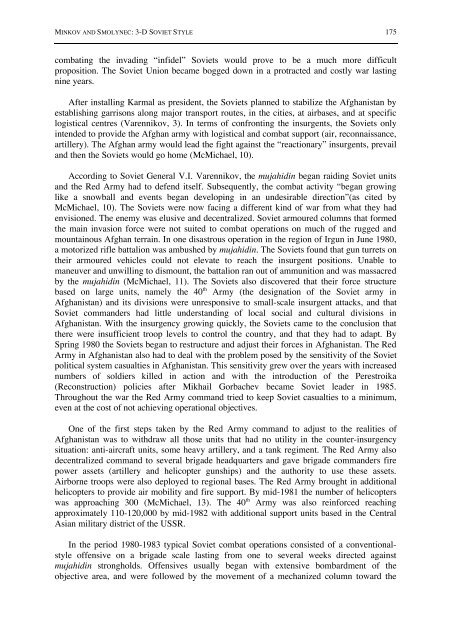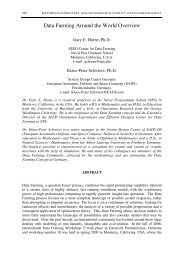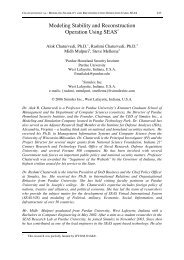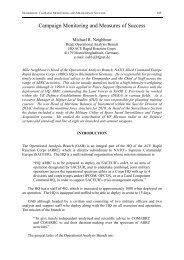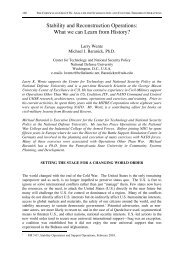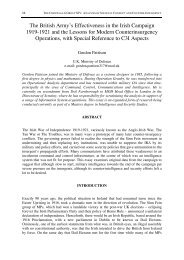Lessons Learned from the Soviet Experience in ... - Cornwallis Group
Lessons Learned from the Soviet Experience in ... - Cornwallis Group
Lessons Learned from the Soviet Experience in ... - Cornwallis Group
Create successful ePaper yourself
Turn your PDF publications into a flip-book with our unique Google optimized e-Paper software.
MINKOV AND SMOLYNEC: 3-D SOVIET STYLE 175combat<strong>in</strong>g <strong>the</strong> <strong>in</strong>vad<strong>in</strong>g “<strong>in</strong>fidel” <strong>Soviet</strong>s would prove to be a much more difficultproposition. The <strong>Soviet</strong> Union became bogged down <strong>in</strong> a protracted and costly war last<strong>in</strong>gn<strong>in</strong>e years.After <strong>in</strong>stall<strong>in</strong>g Karmal as president, <strong>the</strong> <strong>Soviet</strong>s planned to stabilize <strong>the</strong> Afghanistan byestablish<strong>in</strong>g garrisons along major transport routes, <strong>in</strong> <strong>the</strong> cities, at airbases, and at specificlogistical centres (Varennikov, 3). In terms of confront<strong>in</strong>g <strong>the</strong> <strong>in</strong>surgents, <strong>the</strong> <strong>Soviet</strong>s only<strong>in</strong>tended to provide <strong>the</strong> Afghan army with logistical and combat support (air, reconnaissance,artillery). The Afghan army would lead <strong>the</strong> fight aga<strong>in</strong>st <strong>the</strong> “reactionary” <strong>in</strong>surgents, prevailand <strong>the</strong>n <strong>the</strong> <strong>Soviet</strong>s would go home (McMichael, 10).Accord<strong>in</strong>g to <strong>Soviet</strong> General V.I. Varennikov, <strong>the</strong> mujahid<strong>in</strong> began raid<strong>in</strong>g <strong>Soviet</strong> unitsand <strong>the</strong> Red Army had to defend itself. Subsequently, <strong>the</strong> combat activity “began grow<strong>in</strong>glike a snowball and events began develop<strong>in</strong>g <strong>in</strong> an undesirable direction”(as cited byMcMichael, 10). The <strong>Soviet</strong>s were now fac<strong>in</strong>g a different k<strong>in</strong>d of war <strong>from</strong> what <strong>the</strong>y hadenvisioned. The enemy was elusive and decentralized. <strong>Soviet</strong> armoured columns that formed<strong>the</strong> ma<strong>in</strong> <strong>in</strong>vasion force were not suited to combat operations on much of <strong>the</strong> rugged andmounta<strong>in</strong>ous Afghan terra<strong>in</strong>. In one disastrous operation <strong>in</strong> <strong>the</strong> region of Irgun <strong>in</strong> June 1980,a motorized rifle battalion was ambushed by mujahid<strong>in</strong>. The <strong>Soviet</strong>s found that gun turrets on<strong>the</strong>ir armoured vehicles could not elevate to reach <strong>the</strong> <strong>in</strong>surgent positions. Unable tomaneuver and unwill<strong>in</strong>g to dismount, <strong>the</strong> battalion ran out of ammunition and was massacredby <strong>the</strong> mujahid<strong>in</strong> (McMichael, 11). The <strong>Soviet</strong>s also discovered that <strong>the</strong>ir force structurebased on large units, namely <strong>the</strong> 40 th Army (<strong>the</strong> designation of <strong>the</strong> <strong>Soviet</strong> army <strong>in</strong>Afghanistan) and its divisions were unresponsive to small-scale <strong>in</strong>surgent attacks, and that<strong>Soviet</strong> commanders had little understand<strong>in</strong>g of local social and cultural divisions <strong>in</strong>Afghanistan. With <strong>the</strong> <strong>in</strong>surgency grow<strong>in</strong>g quickly, <strong>the</strong> <strong>Soviet</strong>s came to <strong>the</strong> conclusion that<strong>the</strong>re were <strong>in</strong>sufficient troop levels to control <strong>the</strong> country, and that <strong>the</strong>y had to adapt. BySpr<strong>in</strong>g 1980 <strong>the</strong> <strong>Soviet</strong>s began to restructure and adjust <strong>the</strong>ir forces <strong>in</strong> Afghanistan. The RedArmy <strong>in</strong> Afghanistan also had to deal with <strong>the</strong> problem posed by <strong>the</strong> sensitivity of <strong>the</strong> <strong>Soviet</strong>political system casualties <strong>in</strong> Afghanistan. This sensitivity grew over <strong>the</strong> years with <strong>in</strong>creasednumbers of soldiers killed <strong>in</strong> action and with <strong>the</strong> <strong>in</strong>troduction of <strong>the</strong> Perestroika(Reconstruction) policies after Mikhail Gorbachev became <strong>Soviet</strong> leader <strong>in</strong> 1985.Throughout <strong>the</strong> war <strong>the</strong> Red Army command tried to keep <strong>Soviet</strong> casualties to a m<strong>in</strong>imum,even at <strong>the</strong> cost of not achiev<strong>in</strong>g operational objectives.One of <strong>the</strong> first steps taken by <strong>the</strong> Red Army command to adjust to <strong>the</strong> realities ofAfghanistan was to withdraw all those units that had no utility <strong>in</strong> <strong>the</strong> counter-<strong>in</strong>surgencysituation: anti-aircraft units, some heavy artillery, and a tank regiment. The Red Army alsodecentralized command to several brigade headquarters and gave brigade commanders firepower assets (artillery and helicopter gunships) and <strong>the</strong> authority to use <strong>the</strong>se assets.Airborne troops were also deployed to regional bases. The Red Army brought <strong>in</strong> additionalhelicopters to provide air mobility and fire support. By mid-1981 <strong>the</strong> number of helicopterswas approach<strong>in</strong>g 300 (McMichael, 13). The 40 th Army was also re<strong>in</strong>forced reach<strong>in</strong>gapproximately 110-120,000 by mid-1982 with additional support units based <strong>in</strong> <strong>the</strong> CentralAsian military district of <strong>the</strong> USSR.In <strong>the</strong> period 1980-1983 typical <strong>Soviet</strong> combat operations consisted of a conventionalstyleoffensive on a brigade scale last<strong>in</strong>g <strong>from</strong> one to several weeks directed aga<strong>in</strong>stmujahid<strong>in</strong> strongholds. Offensives usually began with extensive bombardment of <strong>the</strong>objective area, and were followed by <strong>the</strong> movement of a mechanized column toward <strong>the</strong>


